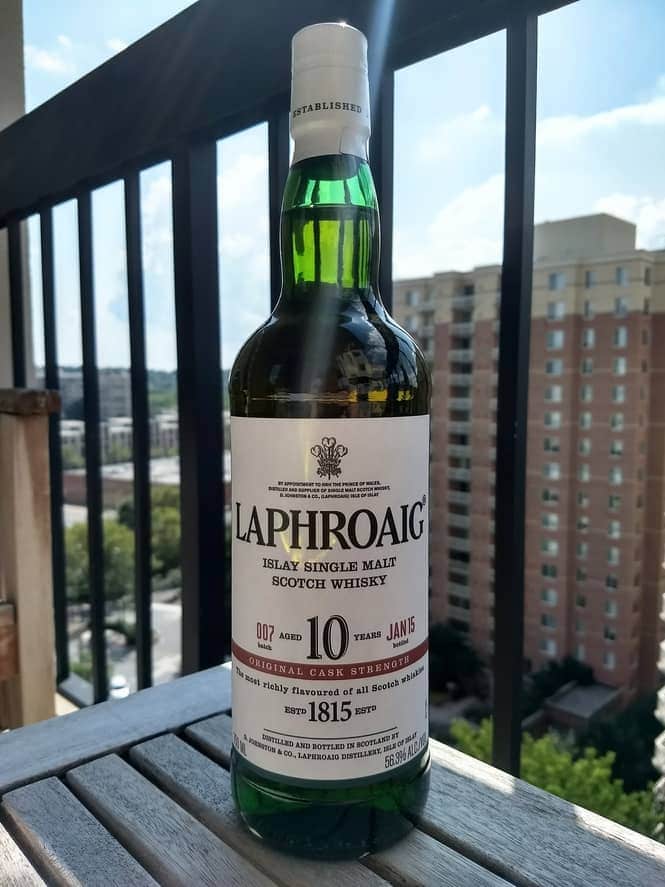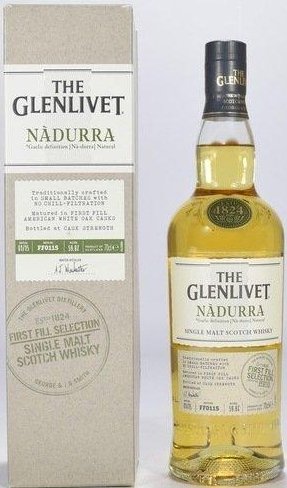
Peated vs Unpeated Edition
I love cask strength whiskeys. They are uncut and uninhibited whiskeys straight from the barrel in their purest form. The smells, tastes, and alcohol are in full force, but do all those things make it better? There is always the risk that the alcohol becomes too powerful for its own good, detracting from the whiskey as a whole. When distillers release cask strength versions of their normal products, it’s interesting to see how they compare. Are they better? Worse? Let’s find out in this ongoing series called Cask Strength Comparison.
In today’s edition, instead of comparing a cask strength whiskey to its lower proof sibling, we’ll see how a peated Scotch is different than an unpeated one (both will still be cask strength). We are comparing Laphroaig 10 Cask Strength Batch 7, a peated Scotch, to Glenlivet Nadurra First Fill American Oak 2015 edition, an unpeated Scotch. I gave both “Top Shelf” ratings, so they are great Scotches to represent each side. Click the links to read each Scotch’s respective review.
I recognize that these two are different in more ways than just peat (distillery, age, barrel used to age), but I believe that it is still useful to compare them to better understand how peat changes a Scotch.
What is Peat? Why does it Matter?
Peat is a compacted mix of dense, decomposed vegetation, earth, and water that historically has been used for fuel, especially in places that didn’t have as many trees. Peat can be found all over the world, not just Islay or even Scotland. It’s usually found in and around bogs, swamps, and other wet areas. The peat’s composition varies based on the vegetation in the area and can impact the flavors that it imparts onto the barley.
The act of “peating” a Scotch is using dried peat to smoke barley before it is mashed and distilled. Since distillers are literally smoking partially decomposed matter, the barley (and later the Scotch) can take on earthy, vegetal, and decaying traits such as including smoke, salt, dust, moss, sulfur, and wood. It’s just like using mesquite wood to smoke meat and impart smoky and mesquite wood flavors into the meat.
How do they Compare?

How to Read the Chart
Laphroaig 10 is in blue, and Glenlivet Nadurra is in orange. The center of the circle indicates none of a trait. Further out the line indicates a stronger presence of that trait.
The scale (from inside to out):
– None
– Light
– Light-Moderate
– Moderate
– Moderate-Strong
– Strong
These two Scotches are radically different, yet excellent in their own ways. As mentioned in the “What is Peat” section, the Laphroaig 10 is teeming with peaty characteristics that are absent in the Glenlivet. The Laphroaig oozes heavy dust, smoke, salt, and vegetal notes that are reminiscent of the ocean, barbequed meats, and mushrooms (but not all peated Scotches are this intense). It’s also spicier and woodier. Sweeter notes such as caramel, citrus, and other fruits are more difficult to taste over the peat but are present in small amounts.
While the Laphroaig 10 Cask Strength is a strong, smoky, and savory Scotch, the Glenlivet Nadurra is sweeter, almost like a dessert. It is a sweet, citrus, and fruit-forward Scotch that really draws its flavors from the barley and the barrel. There are significantly stronger notes of peach, orange, lemon, and honey, as well as chocolate from the malted barley. All that combined feels like peach cobbler or white tea instead of the ocean or barbeque.



